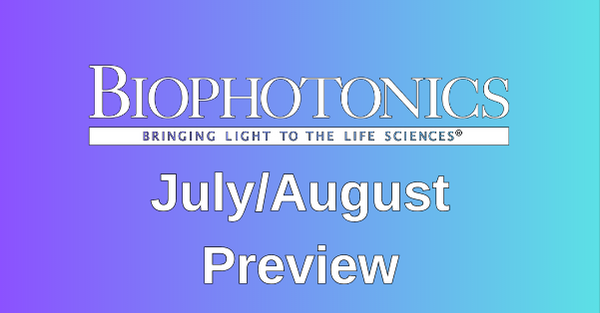Here is your first look at the articles in the upcoming July/August issue of BioPhotonics.

Quantitative Phase Imaging
Cell cultures are fundamental for biomedical research. Still, many traditional analysis methods cause great harm to cells or even require that they are sacrificed before any analysis is possible. Benefitting from developmental leaps in computer science and algorithm development, quantitative phase imaging (QPI) has moved from an obscure, to a modern, cell-friendly imaging method that is becoming indispensable for noninvasive live cell analysis. QPI causes no cell harm and allows for detailed cell analysis, providing high-content quantitative data, informative cell images, and time-lapse videos. QPI has been used for multiple applications, from cell growth, cell differentiation or wound healing assays, to drug screening, spheroid formation, and chemotaxis assays. QPI's future is tightly linked with the transition of regenerative medicine from research to manufacturing, as this requires accredited methods for cell monitoring and data gathering that will not affect living cells while still providing reliable quantitative data for cell quality control.
Key Technologies: Quantitative phase imaging, holographic tomography, digital holographic microscopy, spatial light interference microscopy
Positioning Systems
Recent events show that understanding viral infection is critical to the global population. In particular, understanding the dynamics of the earliest stages of infection is important to developing prevention strategies and therapeutic solutions. Human viruses are typically between 20-200 nm in diameter, making them just beyond the diffraction limit of an optical microscope. This presents challenges in terms of studying the dynamic behavior of viruses. To study this dynamic behavior one needs long range motion, high spatial resolution as well as low noise performance. We discuss how positioning hardware choices made this a reality.
Key Technologies: microscopy, positioning systems
Fluorescence Polarization Imaging
Diagnostic accuracy of the standard of care fine-needle aspiration cytology remains a significant problem in thyroid oncology. Cytologically indeterminate thyroid lesions account for approximately 30% of all biopsied nodules. A method to detect thyroid cancer at the cellular level would be invaluable to reduce diagnostic uncertainty, decrease the number of unnecessary lobectomies, and improve clinical decision making. Using an exogenous fluorophore, methylene blue, in combination with confocal fluorescence polarization imaging, the authors were able to provide accurate, quantitative discrimination of cancerous versus noncancerous thyroid cells in pathologically diverse clinical samples. Results indicate that fluorescence polarization imaging provides a reliable quantitative biomarker of thyroid cancer and holds the potential to shift the paradigm of cellular-level cancer diagnosis from subjective visual assessment to objective measurement.

Key Technologies: fluorescence polarization imaging,
Hyperspectral Imaging
Hyperspectral imaging provides a detailed spectral measurement of every pixel, thereby enabling differentiation of materials, small objects, or multiple samples within an image. Unlike bandpass filters, hyperspectral data enables one to identify very small spectral features. Hyperspectral instruments can be used for monitoring fluorescent signals along with multiple applications. First, hyperspectral fluorescence imaging is being used to develop next generation fluorescent proteins, where its sensitivity and speed enables rapid evolution of fluorescent proteins. The technology has been used to monitor the fluorescence in plants for phenotyping and agricultural plant improvements. Plants have strong fluorescence signals from the photosynthetic system as well as from fluorescent proteins used as markers during the improvement process. The advantage of the hyperspectral detection is that multiple fluorophores as well as the autofluorescent background signals can be detected and quantified with a single hyperspectral scan and separated using spectral data processing.
Key Technologies: hyperspectral imaging
See Ad Pricing